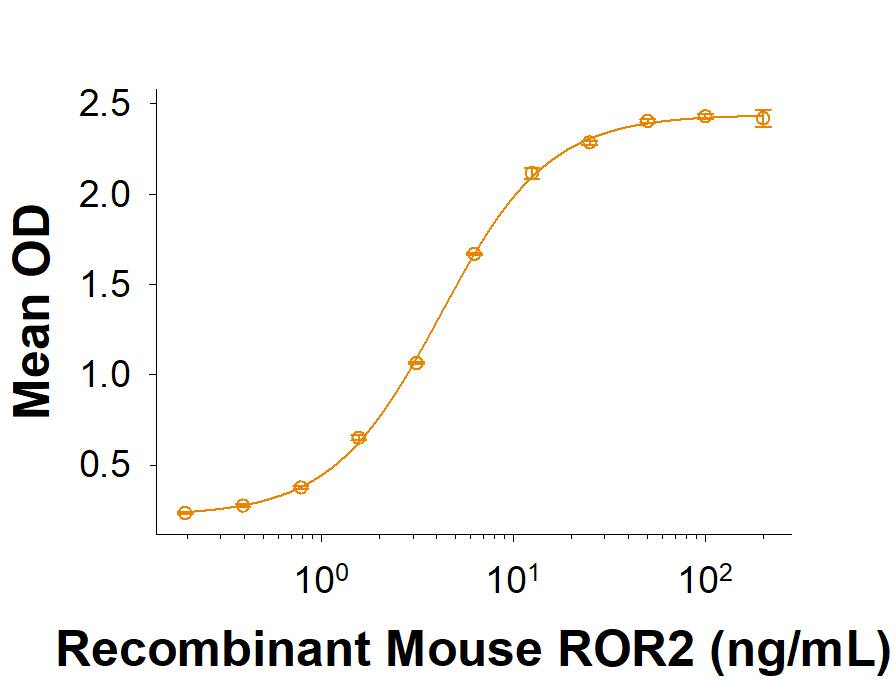Recombinant Mouse ROR2 mFc Chimera Protein, CF
R&D Systems, part of Bio-Techne | Catalog # 11425-RO

Key Product Details
Source
NS0
Accession #
Structure / Form
Disulfide-linked homodimer
Conjugate
Unconjugated
Applications
Bioactivity
Product Specifications
Source
Mouse myeloma cell line, NS0-derived mouse ROR2 protein
| Mouse ROR2 (Glu34-Gly403) Accession # NP_038874.3 |
IEGRMDP | Mouse IgG2A (Glu98-Lys330) |
| N-terminus | C-terminus |
Purity
>95%, by SDS-PAGE visualized with Silver Staining and quantitative densitometry by Coomassie® Blue Staining.
Endotoxin Level
<0.10 EU per 1 μg of the protein by the LAL method.
N-terminal Sequence Analysis
Glu34
Predicted Molecular Mass
68 kDa
SDS-PAGE
80-88 kDa, under reducing conditions.
Activity
Measured by its binding ability in a functional ELISA.
Recombinant Mouse ROR2 mFc Chimera (Catalog # 11425-RO) binds Human ROR2 Antibody (Catalog # AF2064) with an ED50 of 0.600-7.20 ng/mL.
Recombinant Mouse ROR2 mFc Chimera (Catalog # 11425-RO) binds Human ROR2 Antibody (Catalog # AF2064) with an ED50 of 0.600-7.20 ng/mL.
Scientific Data Images for Recombinant Mouse ROR2 mFc Chimera Protein, CF
Recombinant Mouse ROR2 mFc Chimera Protein Binding Activity.
Recombinant Mouse ROR2 mFc Chimera Protein (Catalog # 11425-RO) binds Human ROR2 Antibody (AF2064) with an ED50 of 0.600-7.20 ng/mL.Recombinant Mouse ROR2 mFc Chimera Protein SDS-PAGE.
2 μg/lane of Recombinant Mouse ROR2 mFc Chimera Protein (Catalog # 11425-RO) was resolved with SDS-PAGE under reducing (R) and non-reducing (NR) conditions and visualized by Coomassie® Blue staining, showing bands at 80-88 kDa and 160-180 kDa, respectively.Formulation, Preparation and Storage
11425-RO
| Formulation | Lyophilized from a 0.2 μm filtered solution in PBS with Trehalose. See Certificate of Analysis for details. |
| Reconstitution | Reconstitute at 500 μg/mL in PBS. |
| Shipping | The product is shipped at ambient temperature. Upon receipt, store it immediately at the temperature recommended below. |
| Stability & Storage | Use a manual defrost freezer and avoid repeated freeze-thaw cycles.
|
Background: ROR2
References
- DeChiara, T.M. et al. (2000) Nat. Genet. 24:271.
- Petrova, I.M. et al. (2014) Mol. Neurobiol. 49:303.
- Takeuchi, S. et al. (2000) Genes Cells 5:71.
- Paganoni, S. and A. Ferreira (2003) J. Neurosci. Res. 73:429.
- Endo, M. et al. (2012) J. Cell. Sci. 125:2017.
- Minami, Y. et al. (2010) Dev. Dyn. 239:1.
- Oishi, I. et al. (2003) Genes Cells 8:645.
- Wallkamm, V. et al. (2014) PLoS ONE 9:e109428.
- Al-Shawi, R. et al. (2001) Dev. Genes. Evol. 211:161.
- Matsuda, T. et al. (2001) Mech. Dev. 105:153.
- Cai, S.X. et al. (2014) J. Cell. Physiol. 229:791.
- Xin, H. et al. (2013) Int. J. Mol. Med. 31:583.
- Ford, C.E. et al. (2013) Int. J. Cancer 133:779.
- Rasmussen, N.R. et al. (2014) PLoS ONE 9:e116101.
- Mei, H. et al. (2014) Biochem. Biophys. Res. Commun. 453:703.
- Lu, B.J. et al. (2012) Mol. Med. Rep. 5:1033.
Long Name
Receptor Tyrosine Kinase-like Orphan Receptor 2
Alternate Names
BDB1, NTRKR2
Gene Symbol
ROR2
UniProt
Additional ROR2 Products
Product Documents for Recombinant Mouse ROR2 mFc Chimera Protein, CF
Product Specific Notices for Recombinant Mouse ROR2 mFc Chimera Protein, CF
For research use only
